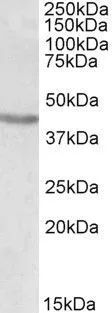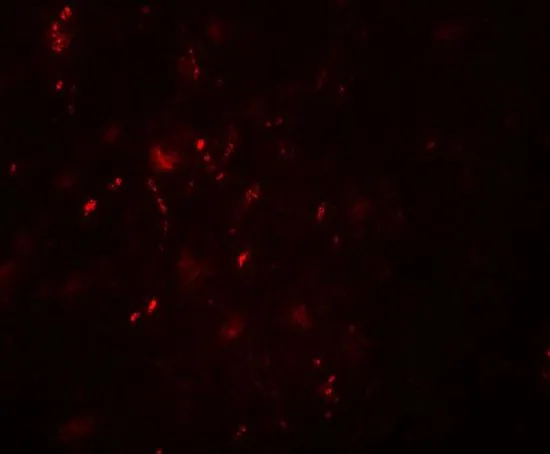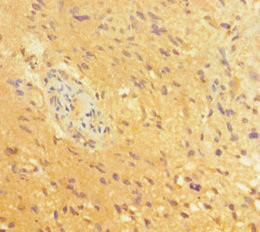Brn2 antibody
GTX114650
ApplicationsImmunoFluorescence, ImmunoPrecipitation, Western Blot, ChIP Chromatin ImmunoPrecipitation, ImmunoCytoChemistry, ImmunoHistoChemistry, ImmunoHistoChemistry Frozen, ImmunoHistoChemistry Paraffin
Product group Antibodies
ReactivityHuman, Mouse, Primate, Rat
TargetPOU3F2
Overview
- SupplierGeneTex
- Product NameBrn2 antibody
- Delivery Days Customer9
- Application Supplier NoteWB: 1:500-1:3000. ICC/IF: 1:100-1:1000. IHC-P: 1:100-1:1000. IHC-Fr: 1:100-1:1000. IP: 1:100-1:500. *Optimal dilutions/concentrations should be determined by the researcher.Not tested in other applications.
- ApplicationsImmunoFluorescence, ImmunoPrecipitation, Western Blot, ChIP Chromatin ImmunoPrecipitation, ImmunoCytoChemistry, ImmunoHistoChemistry, ImmunoHistoChemistry Frozen, ImmunoHistoChemistry Paraffin
- CertificationResearch Use Only
- ClonalityPolyclonal
- Concentration0.2 mg/ml
- ConjugateUnconjugated
- Gene ID5454
- Target namePOU3F2
- Target descriptionPOU class 3 homeobox 2
- Target synonymsBRN2, N-Oct3, OCT7, OTF-7, OTF7, POUF3, brn-2, oct-7, POU domain, class 3, transcription factor 2, brain-2, brain-specific homeobox/POU domain protein 2, nervous system-specific octamer-binding transcription factor N-Oct-3, octamer-binding protein 7, octamer-binding transcription factor 7
- HostRabbit
- IsotypeIgG
- Protein IDP20265
- Protein NamePOU domain, class 3, transcription factor 2
- Scientific DescriptionPOU3F2 belongs to a large family of transcription factors that bind to the octameric DNA sequence ATGCAAAT. Most of these proteins share a highly homologous region, referred to as the POU domain, that occurs in several mammalian transcription factors, including the octamer-binding proteins Oct1 (POU2F1; MIM 164175) and Oct2 (POU2F2; MIM 164176) and the pituitary protein Pit1 (PIT1; MIM 173110). Class III POU genes are expressed predominantly in the central nervous system (CNS). It is likely that CNS-specific transcription factors such as these play an important role in mammalian neurogenesis by regulating their diverse patterns of gene expression (Schreiber et al., 1993 [PubMed 8441633]; Atanasoski et al., 1995 [PubMed 7601453]).[supplied by OMIM]
- ReactivityHuman, Mouse, Primate, Rat
- Storage Instruction-20°C or -80°C,2°C to 8°C
- UNSPSC12352203
References
- Yin L, Ye Y, Zou L, et al. AR antagonists develop drug resistance through TOMM20 autophagic degradation-promoted transformation to neuroendocrine prostate cancer. J Exp Clin Cancer Res. 2023,42(1):204. doi: 10.1186/s13046-023-02776-0Read this paper
- Schaaf ZA, Tat L, Cannizzaro N, et al. WDFY3 mutation alters laminar position and morphology of cortical neurons. Mol Autism. 2022,13(1):27. doi: 10.1186/s13229-022-00508-3Read this paper
- Soares MAF, Soares DS, Teixeira V, et al. Hierarchical reactivation of transcription during mitosis-to-G1 transition by Brn2 and Ascl1 in neural stem cells. Genes Dev. 2021,35(13-14):1020-1034. doi: 10.1101/gad.348174.120Read this paper
- Yang CY, Hung YC, Cheng KH, et al. Loss of CC2D1A in Glutamatergic Neurons Results in Autistic-Like Features in Mice. Neurotherapeutics. 2021,18(3):2021-2039. doi: 10.1007/s13311-021-01072-zRead this paper
- Wang J, Li T, Wang JL, et al. Talpid3-Mediated Centrosome Integrity Restrains Neural Progenitor Delamination to Sustain Neurogenesis by Stabilizing Adherens Junctions. Cell Rep. 2020,33(11):108495. doi: 10.1016/j.celrep.2020.108495Read this paper
- Yamada S, Sato A, Sakakibara SI. Nwd1 Regulates Neuronal Differentiation and Migration through Purinosome Formation in the Developing Cerebral Cortex. iScience. 2020,23(5):101058. doi: 10.1016/j.isci.2020.101058Read this paper
- Kitajima R, Nakai R, Imamura T, et al. Modeling of early neural development in vitro by direct neurosphere formation culture of chimpanzee induced pluripotent stem cells. Stem Cell Res. 2020,44:101749. doi: 10.1016/j.scr.2020.101749Read this paper
- Yoon SJ, Elahi LS, Pașca AM, et al. Reliability of human cortical organoid generation. Nat Methods. 2019,16(1):75-78. doi: 10.1038/s41592-018-0255-0Read this paper
- Wong WT, Matrone G, Tian X, et al. Discovery of novel determinants of endothelial lineage using chimeric heterokaryons. Elife. 2017,6:pii: e23588. doi: 10.7554/eLife.23588.Read this paper
- Enriquez-Rios V, Dumitrache LC, Downing SM, et al. DNA-PKcs, ATM, and ATR Interplay Maintains Genome Integrity during Neurogenesis. J Neurosci. 2017,37(4):893-905. doi: 10.1523/JNEUROSCI.4213-15.2016Read this paper






![ELISA analysis of antigen using GTX60632 Brn2 antibody [6H12]. Black : Control antigen 100ng Purple : Antigen 10ng Blue : Antigen 50ng Red : Antigen 100ng](https://www.genetex.com/upload/website/prouct_img/normal/GTX60632/GTX60632_20170912_ELISA_w_23061123_910.webp)
